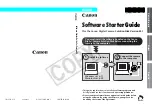
AT-S80 Management Software User’s Guide
Section I: Using the Menus Interface
195
Maximum Request
.
Sets the maximum number of times that the switch retransmits an EAP
Request packet to the client before it times out the authentication
session. The default value for this parameter is 2 retransmissions. The
range is 1 to 10 retransmissions.
Quiet Period
.
Sets the number of seconds that the port remains in the quiet state
following a failed authentication exchange with the clien
t.
The default
value is 60 seconds. The range is 0 to 65,535 seconds.
Re-auth Period
.
Specifies the time period between periodic reauthentication of the
client. The default value is 3600 seconds. The range is 1 to 65,535
seconds.
Re-auth Status
.
Specifies if reauthentication should occur according to the
reauthentication period. The options are Enabled or Disabled.
Current PVID
Displays the current port VLAN identifier or PVID assignment of the
port. You cannot change this value from the Port Based Access
Control Configuration Menu. See Chapter 10, “Virtual LANs” on page
97 for information about assigning a PVID.
Multi-host
Permits you to enable or disable multi-host status.
6. To permit a guest VLAN ID, type
G
.
The following prompt is displayed:
Enter guest VLAN ID >
a. Type a VLAN ID and then press Enter.
The Port Based Access Control Configuration Menu is updated with
the new guest VLAN ID.
7. To enable 802.1x to support multiple hosts, type
O
.
The following prompt is displayed:
Enable or disable multi-host status? >
a. Select
E
to enable multi-host status and
D
to disable multi-host
status.
The Port Based Access Control Configuration Menu is updated with
the status of the multi-host feature.
Summary of Contents for AT-S80
Page 8: ...Contents 8 Appendix A AT S80 Software Default Settings 339 Index 343...
Page 12: ...Tables 12...
Page 24: ...24 Section I Using the Menus Interface...
Page 30: ...Chapter 2 Getting Started with the Menus Interface 30 Section I Using the Menus Interface...
Page 60: ...Chapter 4 Port Configuration 60 Section I Using the Menus Interface...
Page 78: ...Chapter 6 IGMP Snooping 78 Section I Using the Menus Interface...
Page 84: ...Chapter 7 Static Multicast Address 84 Section I Using the Menus Interface...
Page 90: ...Chapter 8 Port Mirroring 90 Section I Using the Menus Interface...
Page 96: ...Chapter 9 Dial in User Configuration 96 Section I Using the Menus Interface...
Page 118: ...Chapter 10 Virtual LANs 118 Section I Using the Menus Interface...
Page 170: ...Chapter 13 Rapid Spanning Tree Protocol RSTP 170 Section II Menus Interface...
Page 176: ...Chapter 14 Bandwidth Control 176 Section I Using the Menus Interface...
Page 206: ...Chapter 18 RADIUS Authentication Protocol 206 Section I Using the Menus Interface...
Page 212: ...212 Section II Using the Web Browser Interface...
Page 250: ...Chapter 23 Port Trunking 250 Section II Using the Web Browser Interface...
Page 254: ...Chapter 24 Port Mirroring 254 Section II Using the Web Browser Interface...
Page 260: ...Chapter 25 Static Multicast Address Table 260 Section II Using the Web Browser Interface...
Page 264: ...Chapter 26 IGMP Snooping 264 Section II Using the Web Browser Interface...
Page 272: ...Chapter 28 Bandwidth Control 272 Section II Using the Web Browser Interface...
Page 284: ...Chapter 29 Virtual LANs 284 Section II Using the Web Browser Interface...
Page 328: ...Chapter 36 Management Software Updates 328 Section II Using the Web Browser Interface...
Page 342: ...Appendix A AT S80 Software Default Settings 342...
Page 346: ...Index 346...
















































